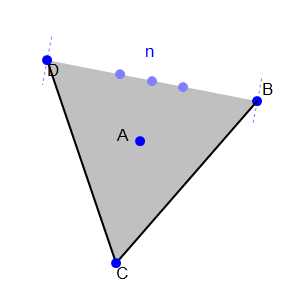Expected Triangle In Regular N-gon
 Consider the
N
vertices of a regular
N
−
gon that is inscribed in a unit circle. There are
(
3
N
)
possible subsets of 3 vertices, which form triangles. If the expected area of the triangle is
Consider the
N
vertices of a regular
N
−
gon that is inscribed in a unit circle. There are
(
3
N
)
possible subsets of 3 vertices, which form triangles. If the expected area of the triangle is
2 4 5 5 + 2 5 ,
what is the value of N ?
This section requires Javascript.
You are seeing this because something didn't load right. We suggest you, (a) try
refreshing the page, (b) enabling javascript if it is disabled on your browser and,
finally, (c)
loading the
non-javascript version of this page
. We're sorry about the hassle.
3 solutions
@Brian Charlesworth Ummm Sir, could you please check the link again....?? It does not work.......
I've updated the link so it should work for you now. The general formula is given in Theorem 2 of the paper.
Log in to reply
Thanks a lot, Sir!! It is amazing how you can find such papers on almost all topics!!
Each triangle has area is appropriate to: n 2 × π = 2 4 5 5 + 2 × 5 ⇒ n = 1 0
Place N-gon at the center of the Argand diagram and label each vertices v 1 , v 2 , v 3 , . . . , v N . ( v 1 at (1, 0) counterclockwise)
Given three vertices, the area of the triangle is equal to 2 1 ∣ ( v a − v b ) × ( v b − v c ) ∣ where v a , v b , v c are radius vectors.
Basically, the code below gets the mean (average) value of triangle areas for each possible value of N.
1 2 3 4 5 6 7 8 9 10 11 12 13 14 15 16 17 18 19 20 21 22 23 |
|
Looking up the value of N where expected area is approximately equal to 0.641184, the answer is 10.
How is this an expected value question?
Note that the general formula for the expected area of a triangle formed in this scenario is
E ( A N ) = 2 ( N − 1 ) ( N − 2 ) 3 N ∗ cot ( N π ) .
Now, assuming that the radical can be attributed to the cot ( N π ) factor, we check to see what value of N we get from the equation
2 4 5 = 2 ( N − 1 ) ( N − 2 ) 3 N
⟹ 5 ∗ ( N 2 − 3 N + 2 ) = 3 6 ∗ N
⟹ 5 ∗ N 2 − 5 1 ∗ N + 1 0 = 0 ⟹ ( 5 N − 1 ) ( N − 1 0 ) = 0 ⟹ N = 1 0 ,
as N must be an integer. After confirming (using a calculator) that cot ( 1 0 π ) = 5 + 2 5 , we can conclude that N = 1 0 .
Here is the paper where the general formula stated above is proved.